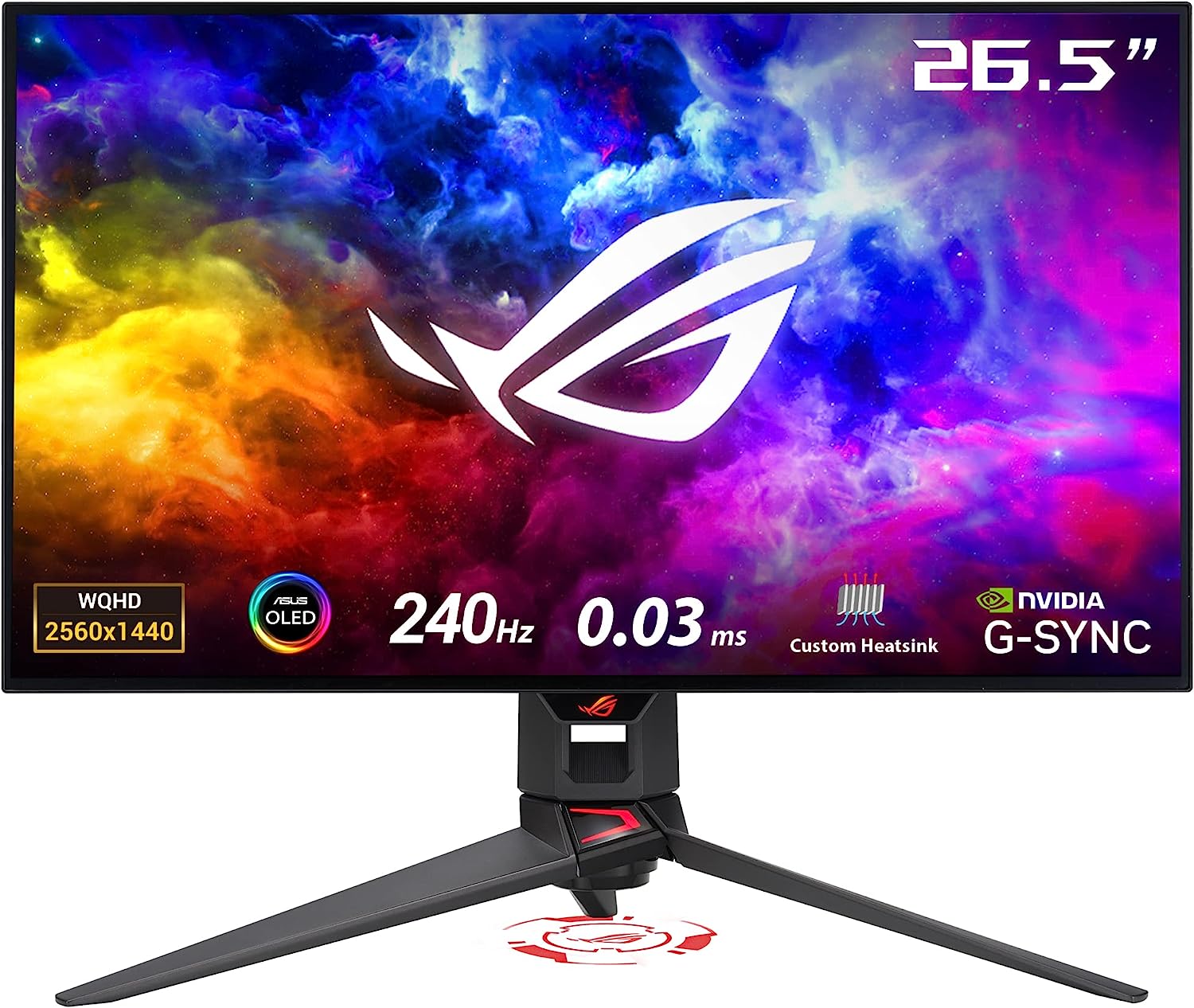Introduction
In the world of gaming, having the right monitor can make a significant difference in your overall experience. With the rise of high-definition content, 1440p gaming monitors have become the sweet spot for gamers seeking a balance between performance and visual fidelity. These monitors offer a higher resolution than 1080p displays, providing crisper images and more detailed graphics without the intense hardware demands of 4K screens. In this comprehensive guide, we’ll dive into the best 1440p gaming monitors available, examining their features, benefits, and what makes them stand out in the crowded market.
Why Choose a 1440p Gaming Monitor?
Choosing a 1440p gaming monitor offers several advantages over both 1080p and 4K alternatives. These monitors provide a significant improvement in image quality and detail over 1080p, without the steep performance requirements of 4K. This resolution hits a sweet spot, delivering stunning visuals while allowing for higher frame rates, essential for a smooth gaming experience.
Improved Visual Clarity
1440p resolution, also known as QHD (Quad High Definition), provides a resolution of 2560×1440 pixels. This is significantly higher than the 1920×1080 pixels of 1080p (Full HD) monitors. The increased pixel count results in sharper, more detailed images, making games look more vibrant and lifelike.
Performance Balance
Compared to 4K (3840×2160 pixels) monitors, 1440p offers a great balance between visual quality and performance. While 4K provides the highest resolution, it also requires much more powerful hardware to run smoothly. For most gamers, achieving high frame rates at 1440p is more attainable and provides a better overall gaming experience.
Cost-Effectiveness
1440p monitors are generally more affordable than their 4K counterparts, making them an attractive option for gamers who want high-quality visuals without breaking the bank. Additionally, because they are less demanding on hardware, gamers can save money by not needing to upgrade to the latest, most expensive graphics cards.
Top 1440p Gaming Monitors
ASUS ROG Swift PG279QZ
Features:
- 27-inch IPS panel
- 165Hz refresh rate
- G-SYNC compatibility
- 4ms response time
The ASUS ROG Swift PG279QZ is a top-tier option, known for its superb color accuracy and fast refresh rate. The G-SYNC compatibility ensures a tear-free gaming experience, making it a favorite among competitive gamers.
Detailed Review
The ASUS ROG Swift PG279QZ is widely regarded as one of the best 1440p gaming monitors available. Its 27-inch IPS panel offers excellent color reproduction and wide viewing angles, ensuring that games look stunning from any angle. The 165Hz refresh rate is ideal for fast-paced games, providing ultra-smooth motion that can give players a competitive edge.
The G-SYNC compatibility means that the monitor synchronizes its refresh rate with the frame rate of compatible NVIDIA graphics cards, eliminating screen tearing and minimizing input lag. This results in a smoother, more responsive gaming experience, particularly important for first-person shooters and other fast-action genres.
Acer Predator XB271HU
Features:
- 27-inch IPS panel
- 144Hz refresh rate (overclockable to 165Hz)
- G-SYNC support
- 4ms response time
The Acer Predator XB271HU combines excellent build quality with high-end gaming features. Its overclockable refresh rate and G-SYNC support make it ideal for those who demand the best performance.
Detailed Review
The Acer Predator XB271HU stands out for its impressive performance and build quality. The 27-inch IPS panel provides vibrant colors and sharp details, enhancing the visual experience of any game. The monitor’s refresh rate can be overclocked from 144Hz to 165Hz, offering gamers the flexibility to push their hardware for even smoother gameplay.
The inclusion of G-SYNC technology ensures that the monitor’s refresh rate matches the frame rate of the GPU, reducing screen tearing and stuttering. This is particularly beneficial in fast-paced games where smooth motion and quick reactions are crucial.
Dell S2719DGF
Features:
- 27-inch TN panel
- 155Hz refresh rate
- FreeSync support
- 1ms response time
The Dell S2719DGF is a budget-friendly option that doesn’t skimp on performance. Its FreeSync support and lightning-fast response time make it a solid choice for gamers looking for value.
Detailed Review
The Dell S2719DGF offers excellent performance at a more affordable price point. The 27-inch TN panel may not provide the same color accuracy and viewing angles as an IPS panel, but it makes up for it with a blistering 1ms response time. This ensures that fast-moving objects in games are clear and free of motion blur, providing a competitive edge in high-speed scenarios.
The 155Hz refresh rate, coupled with FreeSync support, ensures smooth gameplay with compatible AMD graphics cards. FreeSync synchronizes the monitor’s refresh rate with the GPU’s frame rate, reducing screen tearing and providing a more fluid gaming experience.
Key Features to Consider
Refresh Rate
A higher refresh rate ensures smoother motion, which is crucial for fast-paced games. Look for monitors with at least 144Hz to keep up with high frame rates.
Understanding Refresh Rate
The refresh rate of a monitor is measured in hertz (Hz) and indicates how many times per second the screen is refreshed. A higher refresh rate means that the image on the screen is updated more frequently, resulting in smoother motion and less blur during fast-paced scenes. This is particularly important in competitive gaming, where even a slight delay can make a difference.
Response Time
A lower response time reduces motion blur and ghosting. For gaming, a response time of 1ms to 4ms is ideal.
Importance of Response Time
Response time refers to how quickly a pixel can change from one color to another. A lower response time means that the monitor can keep up with rapid changes in the game, reducing motion blur and ghosting. This is especially important in fast-paced games where clarity and sharpness can impact performance.
Panel Type
The panel type affects color reproduction and viewing angles. IPS panels offer better color accuracy and wider viewing angles, while TN panels provide faster response times.
Comparing Panel Types
- IPS (In-Plane Switching): Known for superior color accuracy and wider viewing angles. Ideal for games that require rich, detailed visuals and for those who use their monitors for creative work as well.
- TN (Twisted Nematic): Offers faster response times and generally lower prices. Suitable for competitive gamers who prioritize performance over color accuracy.
- VA (Vertical Alignment): Provides a middle ground with better color accuracy than TN panels and better response times than IPS panels. Good for a balanced gaming experience.
Adaptive Sync Technology
Adaptive Sync technologies like G-SYNC and FreeSync help prevent screen tearing and stuttering, ensuring a smoother gaming experience.
G-SYNC vs. FreeSync
- G-SYNC: Developed by NVIDIA, this technology requires a monitor with a G-SYNC module. It ensures that the monitor’s refresh rate matches the frame rate of the GPU, eliminating screen tearing and minimizing stuttering. Typically more expensive due to proprietary hardware.
- FreeSync: Developed by AMD, this technology is more cost-effective and widely supported. It achieves similar results as G-SYNC but relies on the DisplayPort Adaptive-Sync standard, making it more affordable.
Benefits of 1440p Gaming Monitors
Enhanced Visual Clarity
1440p resolution provides a noticeable improvement in image clarity and detail over 1080p, making games look more immersive.
Immersive Gaming Experience
The increased pixel density of 1440p monitors results in sharper, more detailed images. This can make a significant difference in games with complex graphics, where every detail counts. The enhanced clarity can also improve your overall gaming experience by making it easier to spot enemies, read text, and appreciate the game’s environment.
Better Performance Balance
Compared to 4K, 1440p offers a good balance between visual quality and performance, allowing for higher frame rates without requiring the latest high-end graphics cards.
Optimized Performance
While 4K monitors provide the highest resolution, they also require significantly more processing power to run smoothly. For many gamers, achieving high frame rates at 4K resolution is not feasible without investing in top-tier hardware. 1440p monitors strike a balance, offering excellent visual quality without demanding the latest and most expensive graphics cards.
Wider Field of View
Many 1440p monitors come in larger sizes, providing a wider field of view that enhances the gaming experience, especially in immersive games.
Enhanced Gameplay
A larger screen size combined with higher resolution provides a more immersive experience. Games that feature expansive landscapes, such as open-world RPGs, benefit greatly from the wider field of view. This allows players to see more of their surroundings and enjoy the game’s graphics to the fullest.
How to Choose the Best 1440p Gaming Monitor for Your Needs
Determine Your Budget
1440p gaming monitors come in a wide range of prices. Determine your budget and find a monitor that offers the best features within your price range.
Budget Considerations
When setting a budget, consider what features are most important to you. Higher-end models with features like G-SYNC, high refresh rates, and IPS panels will cost more. However, there are budget-friendly options that still offer excellent performance for gamers who don’t need all the bells and whistles.
Consider Your Gaming Preferences
Different games have different requirements. Fast-paced shooters benefit from higher refresh rates and lower response times, while role-playing games might prioritize better color accuracy and larger screen sizes.
Matching Monitor to Game Types
- First-Person Shooters (FPS): Prioritize high refresh rates (144Hz or higher) and low response times (1ms to 4ms).
- Role-Playing Games (RPG): Look for monitors with good color accuracy and larger screen sizes to enhance immersion.
- Real-Time Strategy (RTS): Balance between refresh rate and color accuracy to see all the details and react quickly.
Check Compatibility
Ensure your graphics card can handle 1440p resolution at the desired frame rates. Also, check if it supports G-SYNC or FreeSync based on your monitor choice.
Hardware Requirements
Before purchasing a 1440p monitor, check your current hardware setup. Ensure that your graphics card is capable of running games at 1440p resolution and that it supports the adaptive sync technology (G-SYNC or FreeSync) of your chosen monitor. If necessary, you may need to upgrade your GPU to get the best performance.
Top Brands for 1440p Gaming Monitors
ASUS
ASUS is known for its ROG (Republic of Gamers) line, which offers high-performance monitors with features tailored for gamers.
ASUS ROG Line
The ROG line from ASUS is designed with gamers in mind. These monitors often feature high refresh rates, low response times, and G-SYNC compatibility. They are built to provide an immersive and responsive gaming experience.
Acer
Acer’s Predator series provides excellent gaming monitors that combine high refresh rates with good build quality.
Acer Predator Series
Acer’s Predator series is known for its high-performance gaming monitors. These monitors often include features like overclockable refresh rates and adaptive sync technology. They are built to deliver a smooth and immersive gaming experience.
Dell
Dell’s gaming monitors are known for their reliability and competitive pricing, making them a popular choice for budget-conscious gamers.
Dell Gaming Monitors
Dell offers a range of gaming monitors that provide good performance at a reasonable price. These monitors often feature fast refresh rates and adaptive sync technology, making them a great option for gamers on a budget.
Setting Up Your 1440p Gaming Monitor
Adjusting Resolution and Refresh Rate
Ensure that your monitor is set to its native 1440p resolution and the highest refresh rate available. This can be adjusted in your operating system’s display settings or your graphics card’s control panel.
Step-by-Step Guide
- Windows Settings: Go to Settings > System > Display. Scroll down to Advanced display settings and select the native resolution (2560×1440). Choose the highest available refresh rate.
- Graphics Card Control Panel: For NVIDIA users, open the NVIDIA Control Panel. Navigate to Change resolution and select 2560×1440. Adjust the refresh rate to the highest setting available.
- Monitor OSD (On-Screen Display): Access the monitor’s OSD menu using the buttons on the monitor. Ensure the resolution and refresh rate settings match those in your operating system.
Calibrating Colors
Use built-in calibration tools or third-party software to adjust your monitor’s color settings. Proper calibration ensures the best visual experience.
Color Calibration Tools
- Windows Calibration Tool: Access this tool via Settings > System > Display > Advanced display settings > Color calibration.
- Third-Party Software: Programs like CalMAN and DisplayCAL offer advanced calibration options.
- Monitor OSD: Many monitors come with built-in color calibration tools accessible through the OSD menu.
Optimizing Game Settings
Adjust in-game settings to balance performance and visual quality. This might include tweaking graphics settings to achieve higher frame rates.
Game Settings Adjustment
- Resolution: Set the in-game resolution to 2560×1440.
- Graphics Quality: Adjust settings like texture quality, shadows, and anti-aliasing to find a balance between visual quality and performance.
- V-Sync: Enable or disable V-Sync based on whether you experience screen tearing.
- Adaptive Sync: Ensure G-SYNC or FreeSync is enabled if your monitor and GPU support it.
Common Issues with 1440p Gaming Monitors and How to Fix Them
Screen Tearing
Enable V-Sync or use G-SYNC/FreeSync to prevent screen tearing.
Fixing Screen Tearing
Screen tearing occurs when the monitor’s refresh rate and the GPU’s frame rate are out of sync. To fix this:
- Enable V-Sync: This option can be found in your game settings or graphics card control panel.
- Use G-SYNC/FreeSync: Ensure these technologies are enabled through the monitor’s OSD and the graphics card control panel.
Ghosting and Motion Blur
Ensure your monitor’s response time is set correctly and enable any motion blur reduction features.
Reducing Ghosting and Motion Blur
Ghosting and motion blur can detract from the gaming experience. To reduce these effects:
- Set Response Time: Adjust the response time in the monitor’s OSD to the lowest setting available.
- Enable Motion Blur Reduction: Some monitors have a setting specifically for reducing motion blur. This can be found in the OSD menu.
Calibration Issues
Use a color calibration tool to fine-tune your monitor’s settings for the best image quality.
Correcting Calibration
Improper calibration can result in poor image quality. To correct this:
- Recalibrate: Use built-in or third-party calibration tools to adjust the monitor’s color settings.
- Check Color Profiles: Ensure the correct color profile is selected in your operating system and graphics card control panel.
Frequently Asked Questions
What is the ideal refresh rate for a 1440p gaming monitor?
The ideal refresh rate depends on your gaming needs, but a minimum of 144Hz is recommended for a smooth experience.
Do I need a high-end graphics card for 1440p gaming?
While a high-end graphics card is beneficial, many mid-range cards can handle 1440p gaming with decent frame rates. Ensure your card supports the resolution and desired settings.
Are 1440p monitors good for non-gaming use?
Yes, 1440p monitors are excellent for productivity and media consumption due to their high resolution and clarity.
What is the difference between G-SYNC and FreeSync?
G-SYNC is NVIDIA’s adaptive sync technology, while FreeSync is AMD’s version. Both aim to reduce screen tearing and stuttering, but G-SYNC monitors tend to be more expensive due to proprietary hardware.
Can I use a 1440p monitor with a console?
Yes, many modern consoles support 1440p output. Check your console’s settings and your monitor’s compatibility.
What size is best for a 1440p gaming monitor?
A 27-inch monitor is a popular size for 1440p gaming, providing a good balance between screen real estate and pixel density.
Conclusion
Investing in the best 1440p gaming monitor can significantly enhance your gaming experience by providing better visuals and smoother performance. Whether you’re a competitive gamer or someone who enjoys immersive single-player adventures, there’s a 1440p monitor out there that meets your needs. By considering factors like refresh rate, response time, and adaptive sync technology, you can find a monitor that offers the perfect blend of performance and visual quality.


